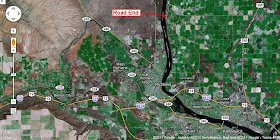I recently took a trip up along the east bank of the Columbia River across from the Hanford area. After passing by a couple of the water slides and man made waterfalls end-of-line-for-canals, the road comes to an abrupt end.
End of the Ringold Road.
The Columbia River Road ends at a landslide.
The site is reached via Road 68 off of Highway 12/Interstate 182 northwest of Pasco
The road formerly continued north along the river before it was closed I believe in the 1960s. Irrigation on the plateau above caused groundwater to become perched on the silts of the Ringold Formation bluffs above the river triggering a series of landslides closing the riverside road.
Landslide scarps on the Ringold bluffs.
Orchards and other irrigated crop land is located above.
Note the green wetland on the mid slope.
The slopes were already steep and potentially unstable with some old landslides before the irrigation began. The slope is steep from toe erosion from the Columbia River. The irrigation has simply caused the frequency of landslides on this reach of bluffs to increase with slopes failing that otherwise would not because of the added water.
Fractured blocks on landslide surface with Columbia River below
Steam plume is from Washington Public Power Supply System nuclear power plant at Hanford
Silt/clay unit of Ringold Formation. Besides acting as a perching,
the unit is very weak from wetting and drying.
One of several headwall scarps exposing silts and clays
Finely layered silts in block on the slide surface

Volcanic ash unit
Volcanic ash
The Ringold Formation is well exposed all along the bluffs on the east side of the Columbia River in the Pasco Basin. Many of the silt units are decidedly white. These light colored silts along with units of volcanic ash give the area its name, White Bluffs. The formation overlies the older Miocene Columbia River Basalt Group and is overlain by Plio-Pleistocene alluvial and soil sediments. The age of the formation is estimated to range from 8.5 to 3.4 million years old. The deposits are are generally not very lithified. The sediments are derived from the ancient Columbia River, Snake River, Palouse River and a few other streams that flowed into the Pasco Basin. The formation has a fair bit of volcanic ash and deeply weathered soils.
The presence of the Ringold Formation hints that the Pasco Basin in south central Washington has been a subsiding basin since at least the end of the Miocene and given the thickness of the underlying basalts in the basin probably for millions of years before that. The preponderance of silts and lake deposits in the upper portion of the formation where the slides are taking place may be the result of changes in the Columbia River gradient down stream of the Pasco Basin. The Columbia River flows through the Cascade Mountains downstream through the Columbia River Gorge. It is easy to imagine a scenario whereby the Columbia would have been blocked by lava flows that would have backed the river up into a lake covering much of the Pasco Basin, but there are alternative mechanisms that could have changed the gradient as well.
The Columbia River Road ends at a spot where landslides soils deeply buried the road, but there are plenty of more landslides to the north beyond the road closure.
The end of the road can be seen in the USGS image above as well as section of the old road to the north
Active slides below irrigated land to the north
(USGS image)
Further north the slide area can be accessed via Columbia River Road from the north via Fir Road. A few homes have been built on a bench area above the river. I have not checked this reach out but the green swath to the east of the homes indicates perched groundwater on the slope.
Homes on bench area above river approximately half mile north of active slide area












Thank you, Dan, once again. Interesting as always. I tried to picture the Columbia blocked by lava and backing up to form a lake - the vastness of such a lake boggles my mind, but then, the sheer size of that river always stuns me. My homework is to look up the following terms: toe erosion, lithified and scarp.
ReplyDeleteHi Dan, Very interesting comments and pictures. I grew up in the area and Ringold Road was open when I graduated High School in 1969. I'm curious about the layers of orange pebbles I recall being embedded in the layers. They were very close to the end of the road in Pasco as I recall. Was just up there and spent more time along the river to the north by the old fish hatchery. Thanks, Ted
ReplyDelete